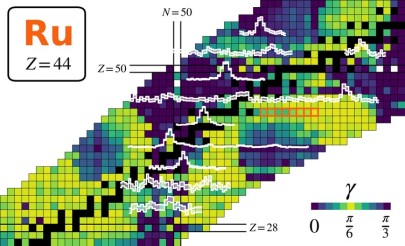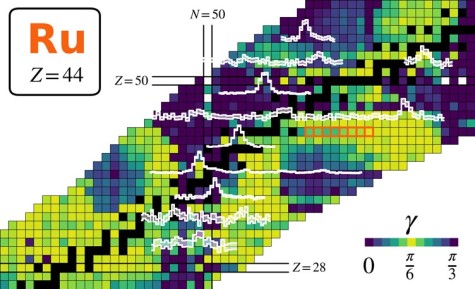Detecting fingerprints of almond-shaped Nuclei
TU Researchers publish study on triaxial structures
2025/11/12 by AG Nörtershäuser/mih
Laser Spectroscopy can be used to determine the relative size of different atomic nuclei of the same element by measuring tiny changes in their atomic spectra. We set up a novel apparatus for such experiments at Argonne National Laboratory and were able to reach outstanding sensitivity. These new developments allowed us to investigate the size of a series of radioactive ruthenium nuclei, which are known to be triaxial in shape: Similar to a coffee bean or an almond, all three axes have a different proportion.

The imprint of a triaxial shape on the nuclear mean-squared radius, however, is non-trivial. To examine this, we used a novel theoretical model and compared it to our new experimental data: The agreement is excellent, but only if we allow for triaxial deformation. This effect is much more significant than what was expected from a simple modelling of the nucleus as a liquid drop. It shows – once again – that the internal, quantum-mechanical arrangement of the nuclear constituents can not be ignored when discussing nuclear size and shape. More generally, this result is a perfect example of how bulk observables are correlated to the complicated internal makeup of quantum many-body systems such as nuclei.
Part of the nuclear chart, in which the “triaxial angle” γ, which can vary between 0 and 60° (π/3), is shown as a colored contour. Above the chart, the resonance spectra of the nine radioactive ruthenium isotopes (marked in orange), which have now been measured for the first time using laser spectroscopy are shown in white.
The publication:
B. Maaß, W. Ryssens, K. König et al.: „Fingerprints of triaxiality in the charge radii of neutron-rich Ruthenium“, Physical Review Letters 135, 012345 (2025)




